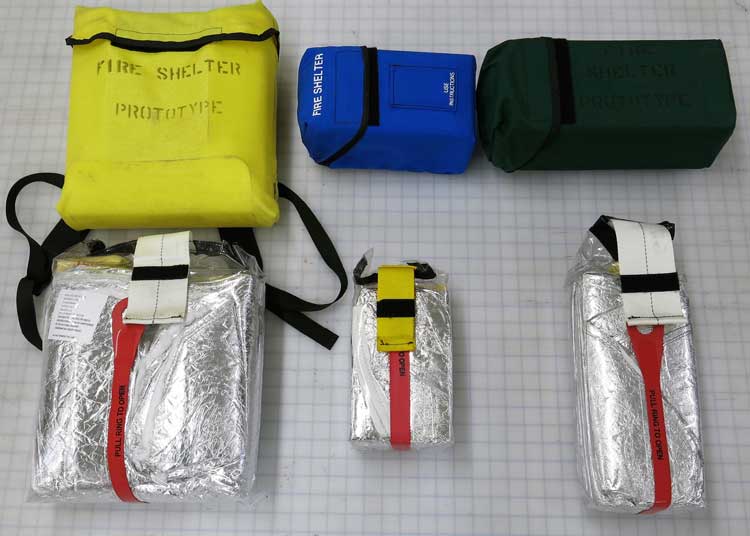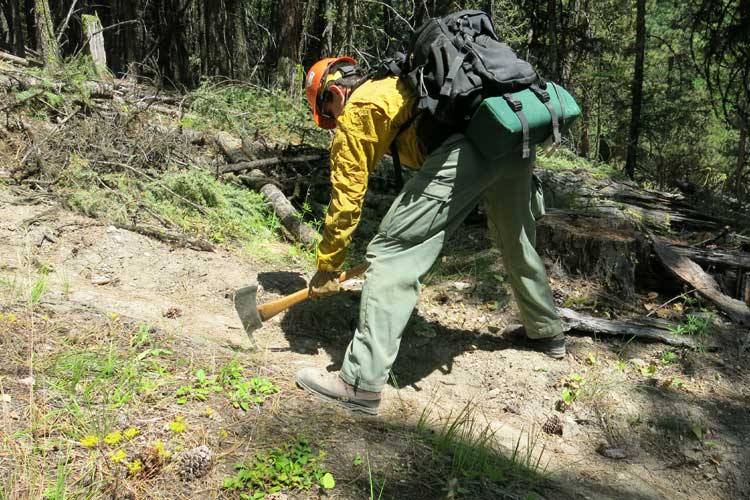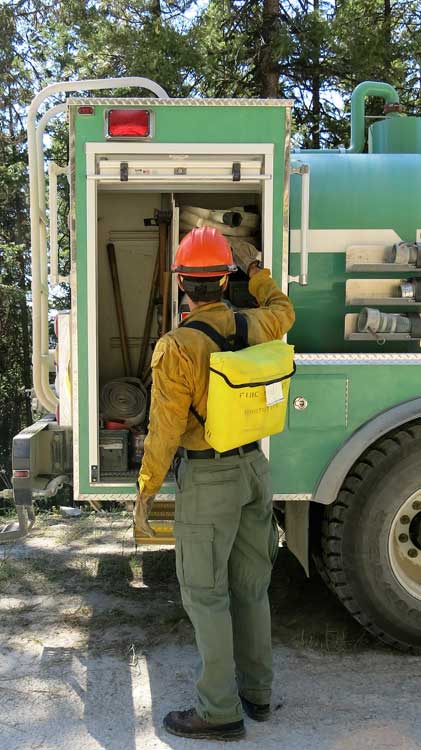
The National Wildfire Coordinating Group (NWCG) Fire Shelter Subcommittee, comprising federal, state, and local wildland firefighters, wildfire safety specialists, fire management officers, and other fire shelter users, has recommended to the NWCG executive board to continue using the 2002 wildland fire shelter instead of deploying any of the new prototypes that had been field-tested in several jurisdictions during the 2018 wildland fire season.
 Wildland fire shelter prototypes for equipment operators and line firefighters were tested during the 2018 fire season. From left, prototype shelter for equipment operators and its carrying case, prototype shelter for line firefighters and its case, and the current issue 2002 fire shelter and its carrying case. (All photos courtesy of U.S. Forest Service’s Missoula Technology & Development Center.)
Wildland fire shelter prototypes for equipment operators and line firefighters were tested during the 2018 fire season. From left, prototype shelter for equipment operators and its carrying case, prototype shelter for line firefighters and its case, and the current issue 2002 fire shelter and its carrying case. (All photos courtesy of U.S. Forest Service’s Missoula Technology & Development Center.)
The executive board’s decision to keep the current fire shelter in use comes after 40 wildland firefighters carried one of two new fire shelter prototypes for “wear testing” as part of the Fire Shelter Project Review, administered by the USDA Forest Service National Technology and Development Program, and initiated in 2014 to identify possible improvements to the fire shelter system.
The NWGC had selected four new fire shelter prototypes for wear testing from 60 prototype fire shelter designs that had shown improved performance in lab tests. Wear test prototype fire shelters were issued to every federal agency in NWCG, U.S. Forest Service, Bureau of Land Management, Fish & Wildlife, U.S. Park Service, and CAL FIRE, says Tony Petrilli, fire shelter project leader for the US Forest Service’s Missoula Technology & Development Center. “For line firefighter shelters we issued them to Interagency Hotshot Crews from California, Idaho, Arizona, and the Northern Rockies to evaluate the durability of the shelters.
“The wildfire environment is very rugged, and fire shelters must be carried by wildland firefighters for years yet still be functional when needed,” Petrilli points out. “We gave them to the crews that could give them the most use and abuse. Other federal agencies and CAL FIRE got their hands on prototype shelters to use and check out too.”
 An Interagency Hotshot Crew firefighter works a fire line while carrying a prototype wildland fire shelter.
An Interagency Hotshot Crew firefighter works a fire line while carrying a prototype wildland fire shelter.
Forty fire shelters for line firefighters and for equipment operators were part of the field testing, Petrilli says, with 20 prototypes going to hotshot crews and 20 shelters to equipment operators. “They were tested from June through September 2018, which is the solid part of the fire season,” Petrilli points out, “but there were no actual deployments of the prototype shelters.”
The biggest job that a fire shelter has to do is be carried around by a wildland firefighter all day, every day, all season long, Petrilli notes. “That doesn’t lend itself to the use of a lot of materials that can withstand high temperatures because of weight, bulk, durability and toxicity,” he says.
After the wear tests, the prototype shelters were returned to the Technology & Development Center, which sent them to a test laboratory at the University of Alberta, Canada, which had conducted prototype testing from 2015 through 2017, for further testing. “They found a slight degredation in the shelters, and a couple of seconds difference in protection, but no great difference,” Petrilli says. “After the results of the testing, and with knowledge of the reduced incidence of fire shelter deployments in the last few years, the committee determined the increase in protection wasn’t worth the increase in weight and bulk for a firefighter to carry around every day.”
The current fire shelter, Model 2000, is an aluminized cloth tent that offers protection in a wildland fire entrapment situation by reflecting radiant heat and providing a volume of breathable air and is shaped like a half-cylinder with rounded ends. Fire shelters have been required as personal protective equipment since 1977.
 A fire equipment operator wears an equipment operator prototype shelter during a response to a wildland fire.
A fire equipment operator wears an equipment operator prototype shelter during a response to a wildland fire.
Petrilli says that the committee took the responses from a 2014 wildland firefighter survey as a factor in its decision. “Firefighters are already carrying 40 to 50 pounds of equipment,” Petrilli points out, “so adding more weight could have an impact on their performance in the field.”
Petrilli notes that, in 2018, fire shelters were deployed by wildland firefighters only in two instances. In 2017, he says, there were only two deployments. “In hundreds of thousands of firefighter days, only two deployments in each of the past two years drew the committee’s attention,” he adds. “The number of deployments of fire shelters have been steadily declining since 2010 with the average number of shelters deployed per year at seven. Back in 1990, deployments averaged 28 per year.”
Petrilli says the committee “looked at every possible item a wildland firefigher carries for a trade-off in weight. “One prototype shelter was a little smaller and lighter weight and offered a little more protection, but we saw issues with the materials it is made from, which are kind of fragile,” he notes. “We put it through a production scenario and the sewing manufacturer commented that some of the material was quite fragile and found that the issue was in the material itself, so we had to eliminate it as not being robust or durable enough.”
There’s a different mindset at work on wildland firegrounds these days, Petrilli believes. “Fire managers are trying to put our firefighters in positions where they will have a high probability of success and a lower risk,” he says. “In addition, firefighters are taking notice of changing conditions and are less apt to accept a high-risk operation.”
Petrilli says that even with the decision to continue using the 2002 fire shelter, the research project won’t entirely go away. “We will be looking at technical advancements,” he says. “The company that submitted the fragile material prototype is still working on improvements to that material. The project is open to looking at test results and data, so there’s no closed door when it comes to advancements in technology.”
ALAN M. PETRILLO is a Tucson, Arizona-based journalist, the author of three novels and five nonfiction books, and a member of the Fire Apparatus & Emergency Equipment editorial advisory board. He served 22 years with the Verdoy (NY) Fire Department, including in the position of chief.

